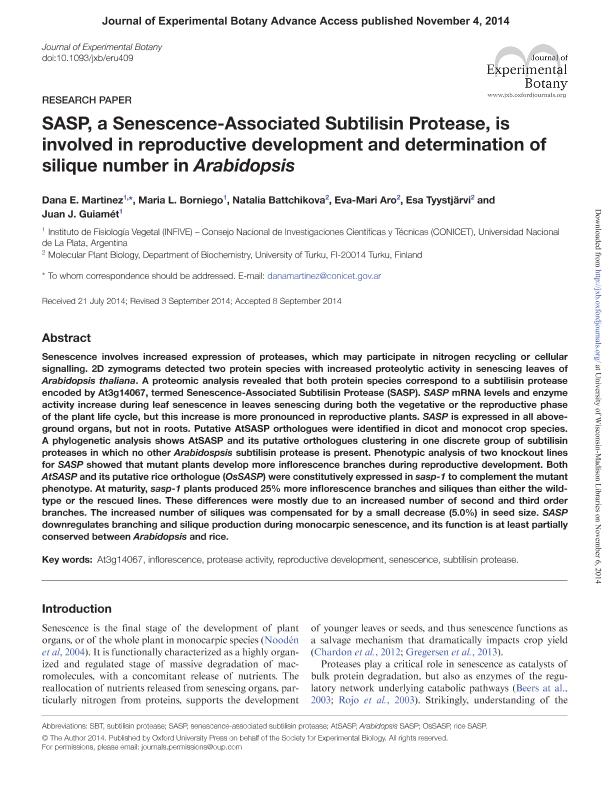Artículo
SASP, a Senescence-Associated Subtilisin Protease, is involved in reproductive development and determination of silique number in Arabidopsis
Martinez, Dana Ethel ; Borniego, María Lucía
; Borniego, María Lucía ; Battchikova, Natalia; Aro, Eva Mari; Tyystjärvi, Esa; Guiamet, Juan José
; Battchikova, Natalia; Aro, Eva Mari; Tyystjärvi, Esa; Guiamet, Juan José
 ; Borniego, María Lucía
; Borniego, María Lucía ; Battchikova, Natalia; Aro, Eva Mari; Tyystjärvi, Esa; Guiamet, Juan José
; Battchikova, Natalia; Aro, Eva Mari; Tyystjärvi, Esa; Guiamet, Juan José
Fecha de publicación:
11/2014
Editorial:
Oxford University Press
Revista:
Journal of Experimental Botany
ISSN:
0022-0957
Idioma:
Inglés
Tipo de recurso:
Artículo publicado
Clasificación temática:
Resumen
Senescence involves increased expression of proteases, which may participate in nitrogen recycling or cellular signalling. 2D zymograms detected two protein species with increased proteolytic activity in senescing leaves of Arabidopsis thaliana. A proteomic analysis revealed that both protein species correspond to a subtilisin protease encoded by At3g14067, termed Senescence-Associated Subtilisin Protease (SASP). SASP mRNA levels and enzyme activity increase during leaf senescence in leaves senescing during both the vegetative or the reproductive phase of the plant life cycle, but this increase is more pronounced in reproductive plants. SASP is expressed in all above-ground organs, but not in roots. Putative AtSASP orthologues were identified in dicot and monocot crop species. A phylogenetic analysis shows AtSASP and its putative orthologues clustering in one discrete group of subtilisin proteases in which no other Arabidospsis subtilisin protease is present. Phenotypic analysis of two knockout lines for SASP showed that mutant plants develop more inflorescence branches during reproductive development. Both AtSASP and its putative rice orthologue (OsSASP) were constitutively expressed in sasp-1 to complement the mutant phenotype. At maturity, sasp-1 plants produced 25% more inflorescence branches and siliques than either the wild-type or the rescued lines. These differences were mostly due to an increased number of second and third order branches. The increased number of siliques was compensated for by a small decrease (5.0%) in seed size. SASP downregulates branching and silique production during monocarpic senescence, and its function is at least partially conserved between Arabidopsis and rice.
Palabras clave:
Sasp
,
Reproductive Development
,
Siliques
,
Arabidopsis
Archivos asociados
Licencia
Identificadores
Colecciones
Articulos(INFIVE)
Articulos de INST.DE FISIOLOGIA VEGETAL
Articulos de INST.DE FISIOLOGIA VEGETAL
Citación
Martinez, Dana Ethel; Borniego, María Lucía; Battchikova, Natalia; Aro, Eva Mari; Tyystjärvi, Esa; et al.; SASP, a Senescence-Associated Subtilisin Protease, is involved in reproductive development and determination of silique number in Arabidopsis; Oxford University Press; Journal of Experimental Botany; 66; 1; 11-2014; 161-174
Compartir
Altmétricas



